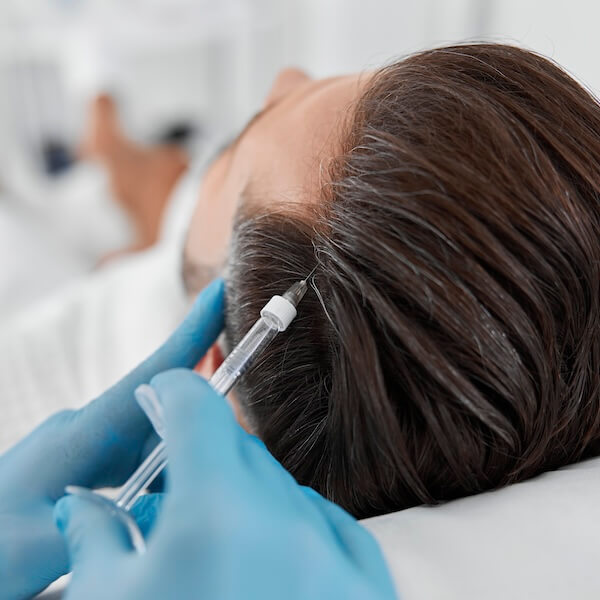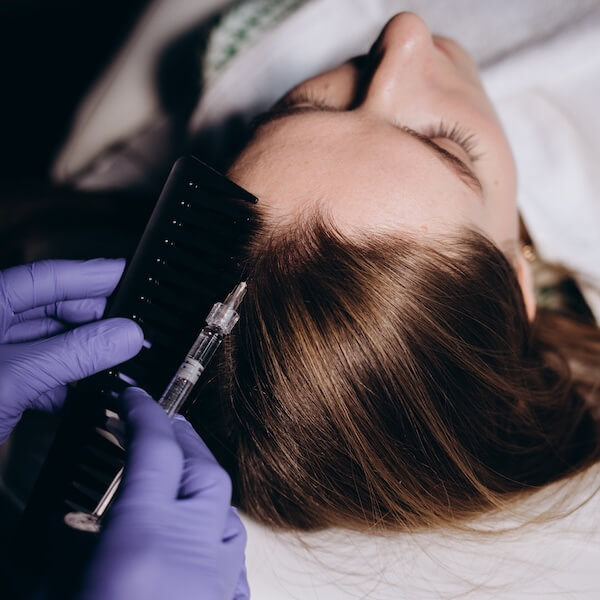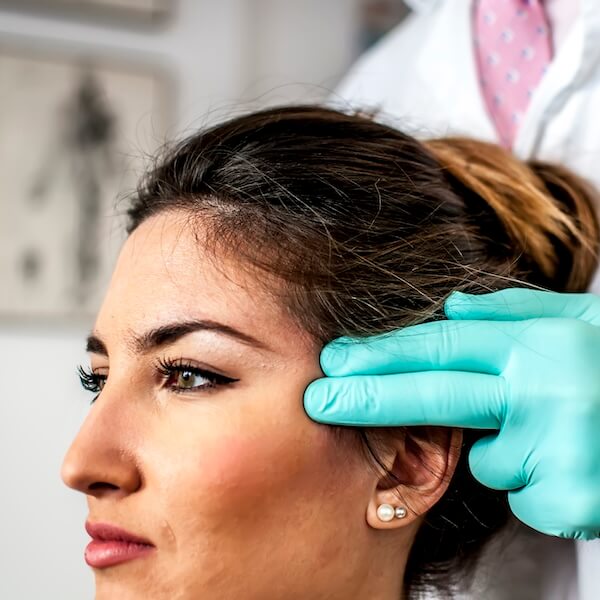PRP for Hair Growth
In the quest for effective solutions to hair loss, Platelet Rich Plasma (PRP) therapy in Dallas has emerged as a forefront treatment, offering hope to millions struggling with various forms of alopecia.
Renowned for its regenerative properties, PRP harnesses the healing power of one's own blood to promote hair growth and restore hair health.
This innovative approach is gaining traction globally, including significant popularity for PRP for hair growth treatments. With minimal invasiveness and promising results, PRP stands out in the realm of cosmetic procedures, particularly in the dynamic field of platelet rich plasma technologies.
Let’s delve deeper into how this cutting-edge treatment is helping redefine the landscape of hair restoration therapies.
What is PRP?
Platelet Rich Plasma (PRP) therapy is a groundbreaking approach to natural hair restoration, utilizing the concentrated power of growth factors found in your own blood to rejuvenate the hair growth cycle and stimulate hair regrowth.
This innovative treatment is based on the premise that the platelet rich plasma extracted from your blood contains essential proteins and growth initiators that can significantly enhance the healing process and tissue regeneration within the hair follicles.

The Science Behind PRP
PRP therapy involves drawing a blood sample from the patient, which is then placed in a centrifuge to separate the platelets from other blood cells like red blood cells and white blood cells.
The concentrated platelet rich plasma—rich in healing and growth-promoting factors—is then injected directly into the scalp at the site of hair thinning or loss.
The high concentration of platelets delivers an abundance of growth factors that promote hair growth by stimulating inactive or newly implanted hair follicles, essentially kickstarting and enhancing the hair growth cycle.
This process not only helps in hair regrowth but also strengthens the existing hair follicles, increasing hair density and thickness, which is crucial for those experiencing androgenic alopecia or other forms of pattern hair loss.
PRP is particularly effective in the early stages of balding and can be a preventative measure to delay more significant hair loss in the future.
Customized PRP Treatments
PRP treatments can be tailored according to the specific needs of the patient, influenced by the severity of their hair loss and their overall scalp health. A board certified dermatologist typically oversees the treatment regimen to ensure optimal results.

The customization of PRP may include varying the platelet concentration, adjusting the formula with additives that might benefit particularly stubborn areas of hair loss, or scheduling a series of injections under a proposed treatment protocol to maximize effectiveness.
Moreover, PRP injections for hair are minimally invasive, cause minimal discomfort, and require no downtime, making them an ideal solution for those looking for an effective yet non-surgical hair loss treatment.
Whether used alone or in conjunction with other treatments like hair transplants or topical minoxidil, PRP therapy offers a promising solution for enhancing hair restoration and combating hair loss.
PRP versus Other Hair Loss Treatments
PRP therapy stands out among hair loss treatments for its natural approach and promising results, especially when compared to traditional methods like topical applications and surgical interventions. Let’s examine how PRP compares to other prevalent hair loss solutions.
Comparing PRP to Minoxidil and Hair Transplants
Topical Minoxidil: Often recognized under the brand name Rogaine, topical minoxidil is a widely used hair loss treatment that works by enlarging hair follicles and prolonging the growth phase of hair.
While minoxidil has been beneficial for many, its results are usually limited to the period during which it is actively used, and it primarily slows hair loss rather than inducing new hair growth.
Moreover, minoxidil requires continuous application and can sometimes lead to scalp irritation or unwanted hair growth on adjacent areas of the face or hands.

Hair Transplantation: This surgical procedure involves removing hair follicles from a part of the head with ample hair and transplanting them to the thinning or balding areas.
Hair transplants can provide significant and visible improvements in hair density and are a permanent solution to hair loss.
However, hair transplants are invasive, have a longer recovery time, and are typically more expensive than PRP. There's also the risk of complications such as infection or scarring.
PRP: A Non-Invasive Alternative with Natural Results
PRP Therapy offers a compelling alternative by utilizing the body's own healing mechanisms to enhance hair thickness and stimulate regrowth without the need for daily topical application or invasive surgical procedures.

PRP is particularly effective because it directly addresses the underlying issues of hair thinning by improving blood flow to the hair follicle and increasing the supply of nutrients and oxygen necessary for hair growth.
PRP treatments can be customized to each patient's specific condition of hair loss, making it a versatile option for both men and women experiencing various stages of hair thinning.
Unlike hair transplants, PRP involves minimal discomfort and no significant downtime, allowing patients to return to their daily activities immediately after treatment.
While other treatments might be preferable depending on the individual's situation, PRP for hair growth stands out for its natural approach, effectiveness in stimulating active hair growth, and ability to improve hair health comprehensively.
For those looking for a less invasive yet effective solution to combat hair loss, PRP offers a promising alternative worth considering.
The PRP Treatment Process
Undergoing PRP (Platelet Rich Plasma) therapy for hair loss is a straightforward and minimally invasive procedure that involves several key steps. Here's what to expect during the PRP treatment process, from the initial consultation to the completion of the procedure.
Initial Consultation and Blood Draw
The PRP treatment begins with a consultation with a board certified dermatologist or a qualified healthcare provider specializing in cosmetic procedures. During this session, the provider will assess your hair loss, discuss your medical history, and determine if PRP is the right treatment option for you.
If PRP is deemed suitable, the process starts with a blood draw, similar to a routine blood test. Typically, a small amount of blood is taken from your arm, which is about the same quantity as that taken during a basic blood test. This blood is then placed into a centrifuge.
Centrifugation and Platelet Concentration
In the centrifuge, your blood is spun at high speeds to separate the different components. This process concentrates the platelets, which are critical for the healing and growth-promoting properties of the PRP. The result is platelet rich plasma that is separated from the red blood cells and white blood cells.
Preparation and Injection of PRP
The concentrated platelet rich plasma is then prepared for injection. This plasma, rich in growth factors, is injected directly into the areas of the scalp that show hair thinning or loss. These scalp injections are meticulously targeted to ensure that the PRP reaches the hair follicles that need rejuvenation. The injections are usually done using a fine needle to minimize discomfort.
Minimal Discomfort and No Downtime
While the idea of scalp injections may seem daunting, PRP injections are generally well tolerated with only minimal discomfort. Most patients describe the sensation as a mild pressure or discomfort during the procedure. Anesthetic options, such as topical numbing creams, can be used to further reduce any potential discomfort.
One of the advantages of PRP treatment for hair growth is that there's typically no downtime required. Patients can return to their normal activities immediately after the procedure. Some might experience mild soreness or swelling at the injection site, which usually subsides within a day or two.
Follow-Up and Maintenance Treatments
Following the initial treatment, patients may require multiple sessions spaced about one month apart to achieve the best results. The exact number of sessions varies depending on individual hair loss conditions and the patient’s response to the treatment. Additionally, maintenance treatments may be recommended every 6 to 12 months to preserve hair density and sustain the growth effects.
The PRP treatment process is a promising approach for those seeking to enhance their hair density and promote hair growth without undergoing invasive surgical procedures. By leveraging the body’s own healing mechanisms, PRP therapy offers a natural and effective solution to combat hair loss.
Effectiveness of PRP for Different Types of Hair Loss
PRP (Platelet Rich Plasma) therapy has shown promising results across various types of hair loss, providing a versatile treatment option for those looking to regain hair density and strength. Let’s explore how PRP performs in treating common conditions such as androgenic alopecia, alopecia areata, and stress-related hair loss.
PRP for Androgenic Alopecia
Androgenic alopecia, also known as male pattern baldness and female pattern baldness, is the most common form of hair loss, affecting millions worldwide. It is characterized by a genetic predisposition to hair thinning, which can lead to a receding hairline and balding at the crown. PRP has been particularly effective for individuals with androgenic alopecia, as it helps to stimulate inactive hair follicles, promote growth, and increase hair thickness. The growth factors in PRP encourage hair follicles to shift from the resting phase to the growth phase, potentially reversing the hair thinning process characteristic of androgenetic alopecia.
PRP for Alopecia Areata
Alopecia areata is an autoimmune disorder that results in unpredictable hair loss, typically manifesting in circular patches. PRP therapy can be beneficial in treating alopecia areata by modulating the immune response and promoting hair regrowth in the affected areas. The concentrated growth factors not only help in reducing inflammation around the hair follicles but also enhance the overall cellular environment to support hair regrowth. Patients with alopecia areata who undergo PRP treatments often notice a reduction in hair fall and a gradual increase in hair density.
PRP for Stress-Related Hair Loss
Stress-related hair loss, or telogen effluvium, occurs when an increased number of hair follicles enter the resting phase, leading to noticeable hair shedding. This type of hair loss is often triggered by intense stress, significant life changes, or health issues. PRP treatments can help counteract stress-related hair loss by extending the growth phase of hair follicles and improving the blood supply to the scalp, which is vital for delivering nutrients and oxygen to rejuvenate the hair.
Assessing Treatment Efficacy
While PRP is not a cure for hair loss, it significantly enhances hair regrowth and quality for many patients.
The success of PRP treatments depends on several factors, including the individual’s overall health, the nature and extent of hair loss, and adherence to treatment protocols.
It's important for patients to have realistic expectations and to discuss the potential outcomes with their healthcare provider.
Clinical studies and patient testimonials often highlight the effectiveness of PRP in providing significant improvement in hair count, hair thickness, and scalp coverage.
However, PRP may be most effective when used in conjunction with other treatments or as part of a broader treatment regimen prescribed by a healthcare professional.
In summary, PRP therapy offers a promising option for treating various types of hair loss by leveraging natural growth factors found in one’s own blood. Its success in stimulating hair regrowth and improving hair health makes it a sought-after non-surgical alternative for those battling chronic hair loss conditions.
Potential Side Effects and Safety of PRP
While PRP (Platelet Rich Plasma) injections are generally considered safe and effective for treating various types of hair loss, like many medical treatments, they do carry potential side effects and risks that patients should be aware of.
Understanding the Risks of PRP Therapy
One of the major advantages of PRP therapy is its safety profile. The treatment involves using the patient's own blood, significantly reducing the risk of allergic reactions or infections. However, as with any procedure involving injections, there is a minimal risk of infection at the treatment site. Proper sterilization and injection techniques by a trained professional are critical to mitigating this risk.
PRP injections may cause temporary discomfort, swelling, or bruising at the injection site. These side effects typically resolve within a few days and can be managed with over-the-counter pain relievers. Unlike treatments that involve surgical intervention, PRP does not require extensive downtime, allowing patients to return to their daily activities relatively quickly.
Rare Complications
In rare cases, patients might experience more significant complications such as nerve injuries, tissue damage, or more pronounced pain. It’s important for patients to choose a qualified practitioner who has experience with PRP therapy to minimize these risks.
Concerns related to underlying health conditions, such as chronic liver disease or chronic tendon injuries, should be discussed with a healthcare provider prior to undergoing PRP treatment to ensure it is safe given the individual’s medical history.
Effectiveness and Limitations
While PRP therapy can stimulate hair growth and improve hair density, it’s not a cure-all for every type of hair loss.
PRP is most effective for conditions like androgenetic alopecia, female pattern baldness, male pattern baldness, and stress-related hair loss, where the hair follicles are still active but may be weakened.
Patients with alopecia areata may also see benefits, as PRP can help promote growth and wound healing by enhancing the function of dermal papilla cells within the hair follicles.
The efficacy of PRP in promoting hair regrowth can be influenced by the hair cycle and terminal hair density, which dictates how noticeable the improvements will be.
PRP Therapy Follow-up and Response Monitoring
After PRP injections, patients are typically advised to monitor for any signs of adverse reactions and report them to their practitioner.
Regular follow-ups can help assess the efficacy of the treatment, allowing adjustments to be made to the treatment regimen.
Most patients see a significant improvement within three to six months after starting treatment, depending on their individual hair growth cycle.
PRP therapy is a promising treatment for hair loss that uses the body’s own healing mechanisms to improve hair health.
With a strong safety profile and potential for significant improvement in hair regrowth, PRP is an appealing option for those looking to address hair thinning without undergoing more invasive procedures.
Long-term Outlook of PRP Treatments
Future of PRP in Hair Restoration
PRP therapy has shown great promise in the field of hair restoration, but understanding its long-term effectiveness and potential for future treatments is crucial for patients considering this option. Here’s a deeper look at what to expect in the long run when choosing PRP for treating hair loss.
Sustainability of Results
The sustainability of PRP therapy results varies among individuals, influenced by factors such as the severity of hair loss, age, and overall health. Generally, patients might see initial improvement within a few months, but ongoing or periodic maintenance sessions are often recommended to sustain hair growth results. This might involve regular PRP injections every six months to a year, depending on the individual’s response to the treatment.
Continuous Research and Improvements
As research continues, the methods and formulations used in PRP therapy are being refined. Innovations such as combining PRP with other treatments like microneedling or medications have shown enhanced results, indicating a promising future for integrated treatment plans. These advancements are likely to improve the efficacy of PRP, making it an even more attractive option for a broader range of patients.
Long-term Care and Management
For those who experience significant benefits from PRP, a long-term care plan is essential. This may include a combination of lifestyle adjustments, nutritional support, and possibly additional hair loss prevention strategies. Consulting with a healthcare provider for a personalized hair care regimen will help maximize and maintain the benefits achieved from PRP therapy.
How to Choose a Provider for PRP
Selecting the right professional for PRP treatments is a critical step in ensuring the safety and success of the procedure.
Qualifications and Experience
It’s vital to choose a provider who is not only qualified but also has specific experience with PRP treatments for hair loss. Look for a board-certified dermatologist or a medical professional who specializes in hair restoration. Their expertise and understanding of hair loss nuances will significantly impact the treatment’s effectiveness.
Evaluating the Treatment Facility
The quality of the facility where the PRP treatments are administered is equally important. A reputable clinic will have the latest technology and adhere to the highest standards of safety and cleanliness. Additionally, a good treatment facility will offer a thorough consultation process, allowing you to discuss your hair loss issues and treatment expectations in detail.
Reviewing Past Patient Outcomes
When possible, review before-and-after photos of previous patients treated by the provider or read testimonials and reviews. This can give you a clearer idea of what to expect and how effective the provider’s treatments have been for other patients with similar hair loss conditions.
Cost Considerations for PRP
The cost of PRP treatments can vary widely based on geographic location, the provider’s expertise, and the number of sessions required.
Understanding Treatment Expenses
PRP therapy generally requires multiple sessions to achieve the best results, and the cost should be considered over the entire treatment span. Some clinics offer packages or payment plans, which can help manage the financial investment required.
Insurance and Financing
Typically, PRP treatments for hair loss are not covered by insurance as they are considered cosmetic procedures. However, discussing payment options and any available financing plans with the clinic can provide manageable solutions to cover the treatment costs.
Combining PRP with Other Treatments
Maximizing the effectiveness of PRP can sometimes involve combining it with other hair loss treatments.
Integrative Treatment Approaches
Combining PRP with therapies like laser treatment or pharmaceuticals such as finasteride or minoxidil can sometimes yield superior results. Each complementary treatment can target different aspects of hair loss, potentially leading to better overall outcomes.
Personalized Treatment Plans
It’s important for patients to work closely with their healthcare providers to develop a treatment plan that addresses their specific needs and combines various therapies in a way that is most likely to produce positive outcomes.
By carefully selecting the right provider and considering all associated costs and complementary treatments, patients can make informed decisions about incorporating PRP into their hair restoration strategy.
Embracing PRP Therapy for Effective Hair Restoration
As we conclude our exploration of PRP (Platelet Rich Plasma) therapy for hair restoration, it's clear that this innovative treatment offers significant benefits for those struggling with various types of hair loss. PRP therapy harnesses the body's natural healing abilities to promote hair growth and improve hair health, making it a compelling option for many.
Effectiveness of PRP Therapy
PRP therapy has demonstrated notable success in treating conditions like androgenetic alopecia, female and male pattern baldness, and even stress-related hair loss. By stimulating inactive hair follicles and enhancing the health of active ones, PRP injections for hair encourage natural hair regrowth and increase the overall density and thickness of hair. This non-surgical intervention is particularly appealing to those seeking alternatives to hair transplantation or to complement existing hair loss strategies.
Safety and Minimal Side Effects
One of the key advantages of PRP therapy is its safety profile. Derived from the patient’s own blood, PRP treatments reduce the risk of allergic reactions and serious side effects. While minor discomfort or bruising may occur at the injection site, these symptoms are typically short-lived and manageable. Additionally, PRP does not involve the risks associated with surgical procedures, making it a safer option for those concerned about the complications associated with hair transplants.
Long-term Strategy and Maintenance
For those considering PRP as a long-term solution, it's important to understand that while PRP can significantly improve hair health, ongoing or periodic treatments might be necessary to maintain the results, especially in cases of chronic or future hair loss. Patients experiencing moderate hair loss may find these maintenance sessions a worthwhile investment to preserve their hair density and appearance.
Broader Applications of PRP
Beyond hair restoration, PRP has found applications in treating a variety of other medical conditions, including sports injuries and chronic tendon problems, due to its ability to promote healing and reduce inflammation. This versatility further underscores the therapeutic potential of PRP in medical and cosmetic fields.
Consulting with Experts
Those interested in PRP therapy should consult with a board-certified dermatologist or a hair restoration specialist who can provide a tailored treatment plan based on their specific hair loss condition and health profile. This personalized approach ensures that each patient receives the most effective treatment, with consideration for their unique health needs and cosmetic goals.
In summary, PRP therapy offers a promising and versatile treatment for hair loss, backed by scientific research and positive patient outcomes. As with any medical treatment, it is crucial to seek advice from qualified professionals and consider all factors, including potential risks, costs, and the likelihood of needing ongoing treatments. For many, PRP provides not just a restoration of hair, but also a boost in confidence and quality of life, making it a valuable consideration in the journey to overcome hair loss.
